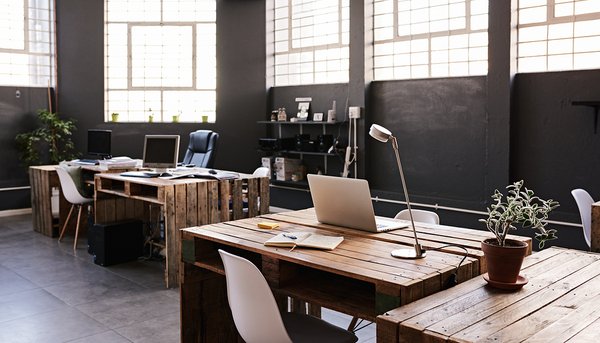Without enough light, water, or the right mix of nutrients, a plant might live, but it may grow poorly, have droopy leaves, and refuse to bloom. Similarly, your workers need certain things to thrive. You want your employees to bloom, don’t you?
That’s why your office design matters. All manner of stimuli — or lack thereof — can get in the way of fostering an environment that promotes innovation. A strong innovation strategy, therefore, includes office design.
Collaboration + Innovation
This starts with the layout of your office — its feng shui, if you will. The National Science Foundation says the placement of everything matters for innovation — the workspaces, the bathrooms, the coffee pot. Why? Innovation is often the direct result of a conversation. Thus, the more that workers bump into each other and have conversations, the better the chances of developing and advancing more and better ideas.
Holding innovation strategy meetings are useful within their structure and context. However, if you’re not careful, they can have a stilted feel to them, like being set up on a blind date versus meet organically. It’s not that it doesn’t work, but it just doesn’t work as well.
This same principle is behind an argument for low or no walls in the office. Being able to see others prompts more conversation. Some conversations will be about how the local team played on Sunday, but that’s okay because the more comfortable your employees get with each other, the more conversations they will have, and the more innovative ideas they will generate.

Innovation + Peace & Quiet
There’s a limit to this concept, of course. Chatty people can prevent quiet people from getting their work done. As important as a conversation is to innovation, everyone needs time in the day to complete their tasks.
The key is to provide options. Have doors that close in the break room. Allow people to work in the lobby if they enjoy the background noise of traffic and heels clicking on the marble floors. Reserve some pods in your space for those who relish the comfort hygge in their environment. These are the sort of people who like to sit on cushions, kick off their shoes, tuck their feet under them and sip a cup of herbal tea while thinking about where no one can watch them.
The Science of Innovation
It all comes down to stress reduction and comfort. If you are wearing shoes that pinch, sitting in an office that’s too hot with harsh lighting and a weird smell coming from the new carpet, your brain has less room in it for creativity because it’s busy suffering from a lot of distractions.
That’s why so many experts advise working in open spaces with plenty of natural light, plants, and other structural and decorative touches to create a pleasant feeling of calm. Remember, though, calm and comatose are different. Introduce some color to your workplace. Think more tropical paradise, less mid-February gray day.

Try to connect your design to your company’s mission whenever possible. Research suggests those who feel a deeper sense of purpose at their company are more innovative. Design to reinforce this concept. Travel agencies could have posters of favored destinations on the walls, and salespeople at furniture companies could have beautiful desks and chairs. Steep your employees in what you’re all about.
The Gensler 2016 Workplace Survey reveals that two-thirds of workers say their workplaces crush creativity and innovation. Don’t let that be you.
IdeaScale can help you implement an innovation strategy.
Most Recent Posts
Explore the latest innovation insights and trends with our recent blog posts.













